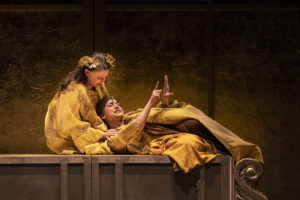
Christoph Graupner was a prolific German composer and harpsichordist from the late 17th and 18th centuries. Born near to the German city of Zwickau in 1683, he decided to study law in Leipzig before changing to follow a career in music. By 1705, he found himself working at the Oper am Gänsemarkt in Hamburg as a harpsichordist in the orchestra, where in 1707, his opera “Dido, Königin von Carthago” was premiered.
This was quickly followed by at least four further operas before he took up a position with the Landgrave of Darmstadt in 1710, where he spent the rest of his career, thanks to the Landgrave refusing him permission to leave. Although he produced a substantial amount of music for his employer, after its opera house burnt down in 1719, he did not compose another opera. Early 18th century Hamburg was an affluent trading city, whose residents enjoyed showing off their wealth, with the opera being one of the main beneficiaries, from which its patrons demanded spectacle and emotional excess.

As a subject for an opera, Dido was a little thin in these respects, so its librettist, Heinrich Hinsch, known for writing works with plenty of subplots, conflicts and love interests to tickle the senses, added extra characters, opportunities for spectacle, gods and even an elephant, on which Dido entered the stage in Act three. He also took the unusual decision to stage Dido’s suicide. It was all done to entertain the senses, rather than to stimulate the intellect.
Although the central story follows Virgil’s simple narrative of Dido and Aeneas’ doomed love, the tangential subplots concerning the numerous extraneous characters turn the work into a complex web of relationships, all with their own love agendas, who intrigue to secure their aims; and such is the scale and detail of the intricacies that even a brief summary is beyond the scope of this review. The problem, of course, in staging this work is how to keep the focus on the central plot involving Dido, without being overly distracted. Colonna’s Direction Cannot Overcome the Defects of the Libretto The director responsible for solving this problem was Deda Cristina Colonna, whose area of expertise lies in dance and presenting historically informed performances.
Although she achieved a degree of success in highlighting the role of Dido, the constant shifting between subplots undermined the tensions that held the structure together; too often the tensions would rise, only to be left hanging as a new character entered with an unrelated concern. It was a problem that was magnified by Domenico Franchi’s costumes, which, although very beautiful in their own right, had little to differentiate one minor character from another, leaving the audience wondering exactly who it was and if they had been seen before. The overall effect was one of mild frustration; one could not easily settle into the drama.
Of course, there were many very successful scenes, but they were mainly restricted to those that were closely related to Dido and the central narrative. Franchi’s stage and costume designs were clearly related to the drama’s classical origins, especially the costumes with their defining feature being their coloring; everything was red, white and gold. This gave the scenes a lavish, regal finish and the impression of palatial splendor, suitable for its queen, Dido.
The entire first part of the opera did not vary from this color scheme, and although it looked brilliant, even overwhelming, for the first few scenes, it soon became oppressive; structures, costumes, props, and furniture were all red, white and gold. It was too heavy, and even impacted on one’s ability to appreciate the full beauty and emotional variety of the music. On the positive side, it perfectly captured Dido’s psychological state, who is trapped by her fears of losing Aeneas and of defying the will of the gods.
At the beginning of the second part, the colors changed briefly to a green and silvery color; it was as if a blast of fresh air ripped through the theatre as everything became lighter and more positive. Colonna and Franchi dealt reasonably well with the spectacular effects. For example, Juno’s appearance at the beginning of Act one was beautifully staged, with the golden goddess descending from the heavens, hovering above the stage as she delivered her message to Dido.
However, it was the large golden elephant that carried Dido onto the stage to watch the mock sea battle that really caught the attention, to which a horn trumpeting in the orchestra added a little amusement. Given Colonna’s background in dance, it was not surprising that the choreography was imaginative and aesthetically well-crafted, with the heavily stylized movements of the singers during the ensemble pieces being particularly notable. Overall, Colonna made an imaginative and brave effort to bring the work to the stage in a visually, aesthetically and dramatically convincing manner underpinned by her understanding of historical practices.
Unfortunately, she was unable to overcome the libretto’s shortcomings to the extent the many of the subplots passed by in a perfunctory manner, disrupting the tensions built up around the main narrative while adding little of interest. Graupner’s Compelling Score Graupner’s music, however, is of a different order. Not only did it align nicely to the dramatic twists and turns of the plot while enhancing and reflecting the emotional states of the characters, but it was also very imaginative in its construction.
The score possesses a rich tapestry of colors with an engaging textural variety, from which Graupner frequently allows the voices of individual instruments to emerge with stunning effects. He also displayed skill in constructing the melodic line, which he often furnished with an attractive tune. It was two vocal ensembles, the sextet, “Più crudo tiranno,” and the beautiful quartet, “Wie lange soll ich noch der Liebe Gaukelspiel,” which builds the harmonies via a solo and a duet into the quartet, that stood out musically.
The musical director Andrea Marcon elicited a lively, bright performance from La Cetra Barockorchester, in which he successfully revealed the work’s remarkable textures and captured its attractive melodies. He was also attentive to the needs of the singers as well as the individual soloists within the orchestra, which gave the sound a pleasing balance, drew out the detail of the score, and added a confident ease to the sound. Johannsen’s Captivating Performance as Dido The structural imbalances of the libretto were reflected in the degree to which the singers were able to characterize their parts.
In many cases, the characters were fairly flat and one-dimensional, although this was certainly not the case for Dido, played by soprano Robin Johanssen. Using her wonderful technique and expressive skills, she gave voice to Dido’s wildly changing psychological and emotional states, which at times teetered on madness. Her recitatives were detailed, lively and forcefully delivered, underpinned by her strong stage presence, while her arias were sensitively fashioned to bring out their full emotional depths.
In the aria “Agitato del tempeste,” for example, Dido likens her situation to a boat in a storm, searching for a safe harbor, for which she produced a forceful rendition with strongly shaped embellishments to reflect her anxieties, while for the aria “Komm doch, komm, gewünschter Teil,” she voiced her desire to leave the world with a poignant rendition that superbly captured her world-weary sadness. However, it was the roller-coaster aria “Alma tradita” that really showed off her ability, as she moved and moulded her voice to capture the flow of her feelings as they shifted between pain, rage, sadness, and loss following Aeneas’ departure. While it is Dido’s fears and guilt that drive the narrative forward, leaving little space for the other characters to impose themselves, many of the singers did manage to make notable contributions.
Dido’s sister, Anna, gave soprano Alicia Amo the opportunity to show off her attractive singing voice. In Act one, scene five, she sings a series of three arias, “Süßeste Freiheit,” “Holde Nahrung reger Herzen,” “Nume alato,” and an arioso, “Glückselig ist wer Amors Pfeil verlacht,” separated by passages of accompanied and dry recitative, which enabled her to craft lines of exquisite delicacy ornamented with pleasing embellishments, incorporating elegant trills that showed off the allure and agility of her voice. After which, her character faded somewhat into the background before acceding to the throne in the final scene following Dido’s suicide.
Hiarbas is in love with Dido. However, not only is his love not returned, but he is chosen to be sacrificed to the gods, much to the dismay of Menalippe, who is in love with him. Bass-baritone Andreas Wolf, who essayed the role, produced an emotionally expressive performance that captured his impulsive nature.
In his aria, “Durch Feuer und Brand, durch Wütenund Morden,” he rages at being rejected by Dido, but within a matter of minutes, he is dreaming of love with Menalippe in the aria “Holde Augen, meine Lust,” which he delivered with equal conviction. His singing was underpinned by his pleasing articulation of the text, a fine technique, and his ability to embellish the vocal line. It is also a voice with substantial power that allows him to dominate scenes.
Menalippe was played by soprano Jone Martinez, who was also parted as the goddess Juno. She displayed a fresh, bright, flexible voice with a beautiful timbre, which she used confidently and expressively to portray both characters. As Juno, she sang two beautiful arias, the second of which, “Auf Dido, auf! Dich ruft,” allowed her to show off her vocal agility as she delivered a versatile passage of coloratura while hanging in midair, above the stage.
Menalippe’s enchanting aria, “Wozu wollt ihr euch nun enschlaffen,” was sung with a gentle delicacy that captured the full beauty of her voice. Baritone Jose Antonio Lopez has a strong stage presence that allowed him to impose his character, Juba, Prince of Tyros, onto the drama. He possesses a resonant, expressive voice, which he used intelligently to articulate the text, and his deeply held feelings for Anna, which he illustrated wonderfully in the aria “Constante il mio core,” accompanied by a delightful violin and recorder solos in the orchestra.
Surprisingly, the tenor Jacob Lawrence did not have the effect that might have been expected. Although he sang well, his individual contributions were fairly restricted; he had only two arias to sing. However, he did his utmost and produced a solid performance in which his pleasing timbre and forceful singing impressed.
Tenor Derek Antoine Harrison playing the roles of the priest Disacles, and Venus’ messenger, Mercurius, bass Simon Unterhofer as Elgabal, bass Matthias Kofler as the nobleman Bomilcar and tenor Jorge Franco as Aeneas’ friend, Achates, all put in energetic performances but had limited opportunities to show off their skills. Overall, the performance of “Dido, Königin von Carthago” will be remembered for the brilliance of its music rather than for the strength of its drama. Whilst the central narrative was nicely crafted, in which the part of Dido was superbly handled, there were too many characters involved in fairly dismal subplots, which did not have the necessary frisson to generate interest; they existed solely for singers to show off their singing skills, which undermined the dramatic tension of the work.
While Colonna’s direction was successful in certain areas, she was unable to maintain the necessary dramatic momentum, which the oppressive coloring of the staging and similarity of the costumes exacerbated. Categories.














